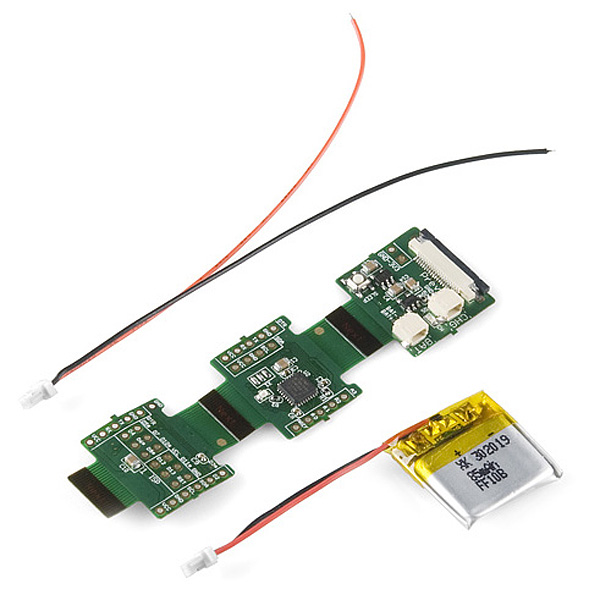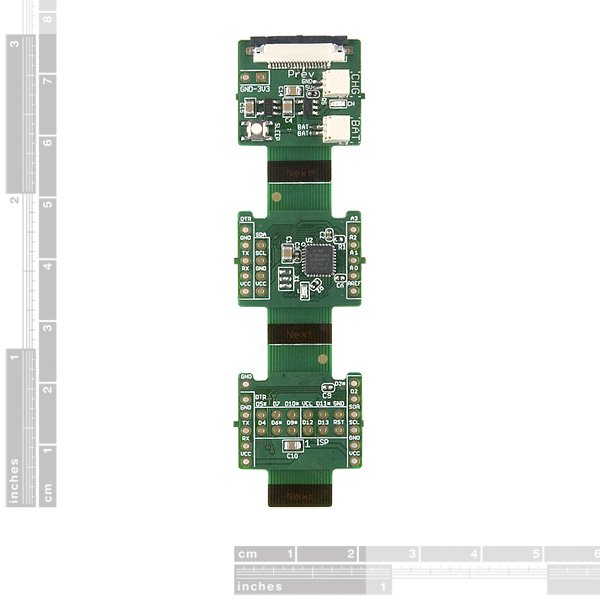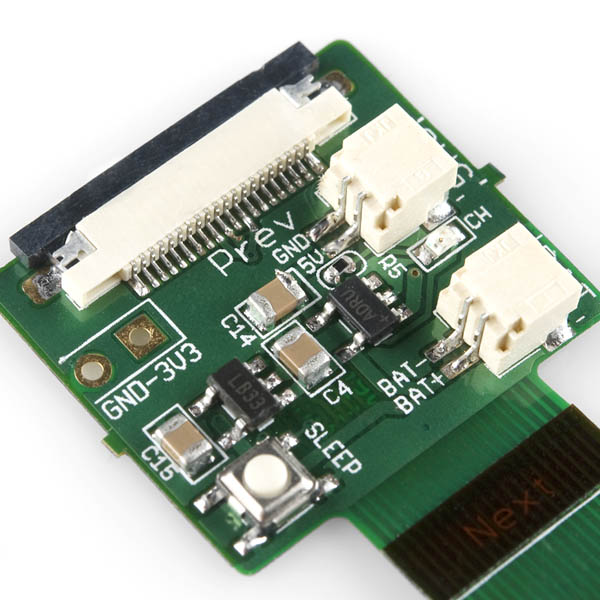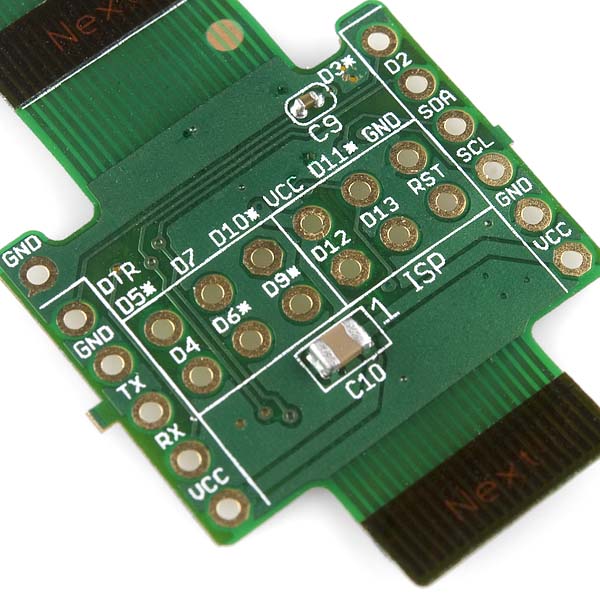Seeeduino FILM
Replacement: None at this time. We are no longer carrying the Seeeduino FILM in our catalog. This page is for reference only.
The Seeeduino FILM is an Arduino compatible development platform for space-sensitive projects. It’s flexible, super slim, has a built-in Li-Po charger, and is designed for wearable applications. FILM and other extension FRAMEs can be simply connected via the 20 pin universal bus like a chain. Native 2.54mm pitch pins also enables quick prototyping.
At the heart of the FILM is an ATMega168 with an Arduino Bootloader. You can use the Arduino IDE, along with an FTDI (or other USB to serial adapter) to program the FILM just like a full-sized Arduino.
- ATMega168 with Arduino bootloader
- 0.1" pin spacing
- 20 pin daisy-chain bus
- Built-in charger circuit
- Flexible circuit board
- 85mAh battery included
Seeeduino FILM Product Help and Resources
Core Skill: Programming
If a board needs code or communicates somehow, you're going to need to know how to program or interface with it. The programming skill is all about communication and code.
Skill Level: Rookie - You will need a better fundamental understand of what code is, and how it works. You will be using beginner-level software and development tools like Arduino. You will be dealing directly with code, but numerous examples and libraries are available. Sensors or shields will communicate with serial or TTL.
See all skill levels
Core Skill: Electrical Prototyping
If it requires power, you need to know how much, what all the pins do, and how to hook it up. You may need to reference datasheets, schematics, and know the ins and outs of electronics.
Skill Level: Competent - You will be required to reference a datasheet or schematic to know how to use a component. Your knowledge of a datasheet will only require basic features like power requirements, pinouts, or communications type. Also, you may need a power supply that?s greater than 12V or more than 1A worth of current.
See all skill levels
Comments
Looking for answers to technical questions?
We welcome your comments and suggestions below. However, if you are looking for solutions to technical questions please see our Technical Assistance page.
Customer Reviews
No reviews yet.







Maybe you should sell Desk Pets, particularly the ones with an included controller-charger (such as SkitterBot and TrekBot). I think I have confirmed that they are the correct polarity for the Seeeduino Film (I'm not fully sure of which way the connector goes).
If you want to check for yourself, note that, when the charger is plugged into the SkitterBot, the negative terminal is on the left if you have the bug upright and are looking at the side with the switch.
This is $19.00 on the Seeeduino website..?
How does this fare with the 2000mAh li-po (below)? Does the built-in charging circuit facilitate 3.7v? https://www.sparkfun.com/products/8483
I've had an issue where I've exceeded the flex limit on the charging/power frame section, which seems to disconnect the battery from the power supply. Pressing on C14 lightly will bring the connection back while I'm pressing on it, but going anywhere near the sleep switch is almost guaranteed to break it again.
Has anyone seen this issue? Is there a trace I can 'blue wire' to fix it? I'll try the Seeed forums too, but there are a lot of awesome people on SF too.
(This is not a reply by the way; I'm only using the reply option because for some reason the normal comment option doesnt work)
Hi,
is it possible to order extra batteries for the Seeeduino? And how long does it take to charge one battery?
thanks, Ralph
The battery connector seems to be JST-like but smaller.
What's the battery terminal connector type called so that I can get a replacement and plug in a larger capacity battery?
Has anyone tried 'cramming' this into a model rocket or a simple UAV yet? :)
This is great! Is it possible to hook up with the xbee? If so, how?
Probably the same way you'd hook up XBee now -- use their breakout board with headers or (since this is soooo small) just wire directly
I just got mine, popped a mini-USB plug on it for power and threw some right angle headers on the programming FRAME and BAM uploaded a sketch, first-shot, no problems (Use Duemilanove w/168 Setting). It works like a freaking charm. A word of advice, though, the programming port pin-out (obviously) doesn't match the FTDI Breakout, I just used a couple of jumpers to get the right pins connected, they're all nicely labeled on the FILM.
I can't say enough about how small this thing is... I'm using it for a wearable application, but I can imagine that even in a more weight sensitive application (like tiny quad-rotors?) the weight is nearly negligible, even with the Li-Po Battery.
Very. Freaking. Nifty.
Another way I might convey how light this thing is would be to mention that the Mini-USB breakout that I wired as power-in is at least twice as heavy as the whole FILM. (adding headers and MiniUSB probably quadrupled the weight, lol)
So... the logic level for this board is 3.3vdc but the datasheet says 5v Compatible. What does that mean exactly?
I have a 5vdc FTDI board, can I program with this or will I cook it?
Wait... don't shout 'idiot' yet, I understand now, lol. It's not so much that I thought It would work as I "hoped" it would work... but I just remembered I can switch the solder jumper on my 5vdc FTDI breakout and go 3.3 anyway.
Oh these are too freaking cool... FreeDay purchase.
Excellent! But I'm having difficulties understanding how the power consumption can be as low as 5 microamperes or even 1.6 as stated in the datasheet when the voltage regulator will take at least 240 microamperes in sleep mode. Am I missing something here? I'd like to have this as a watchdog for my fridge (to sound an alarm when the door is open too long) I would need to power it down to save mAh...
(This is not a reply by the way; I'm only using the reply option because for some reason the normal comment option doesnt work)
Hi,
is it possible to order extra batteries for the Seeeduino? And how long does it take to charge one battery?
thanks, Ralph
Very cool and unique!
I bought it because it fits inside the film container. It's quite amazing.
Nah, totally worth a post, it's really incredible how tiny this thing is. I'm holding it right now and I'm stunned, lol.
And it's flexible too. You could tape it to a can.
Is power transfered through the ribbon connector, or does each board need its own cable going to it?
It took me forever to find this with the search bar. I only found it because I misspelled seeduino, and found out it actually is spelled seeeduino.
Definitely an awesome design, though i would like to have seen it with the 328p
This might just be the best controller idea I've ever seen. I'd like to see the same thing with a built in motor driver.
That was what went through my mind as well! You'd have to keep the current load fairly small through such thin boards, even with a beefy motor driver, right?<br />
<br />
"Innovate with China"? Hmm...
Very cool! What is the weight?
"Our scales don't go that low." This might be the situation here.
Can we connect 2 of it with that next/prev ports ? how does it works ?
Yes, you can connect multiples. Check out the last page on the datasheet for pin assignments.